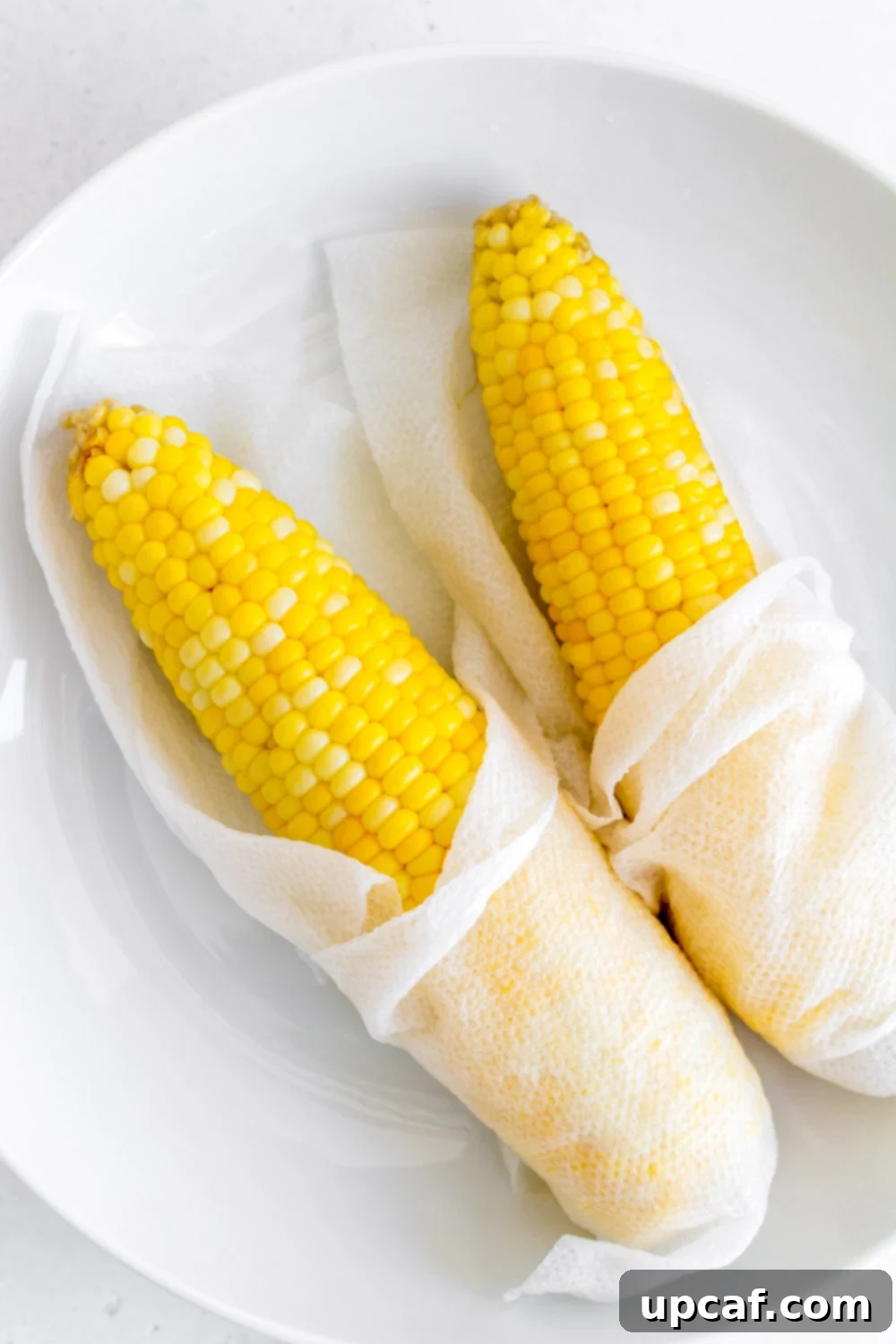Mastering Corn on the Cob: 6 Delicious & Easy Cooking Methods
As summer approaches, there’s a particular joy that comes with fresh corn season. Those vibrant, sweet kernels, bursting with flavor, are a true culinary delight. Whether you’re planning a backyard barbecue, a simple weeknight dinner, or looking for a healthy snack, perfectly cooked corn on the cob is always a crowd-pleaser. However, if you’re new to cooking corn, the sheer number of methods can feel overwhelming, and nobody wants tough, mushy, or flavorless corn.
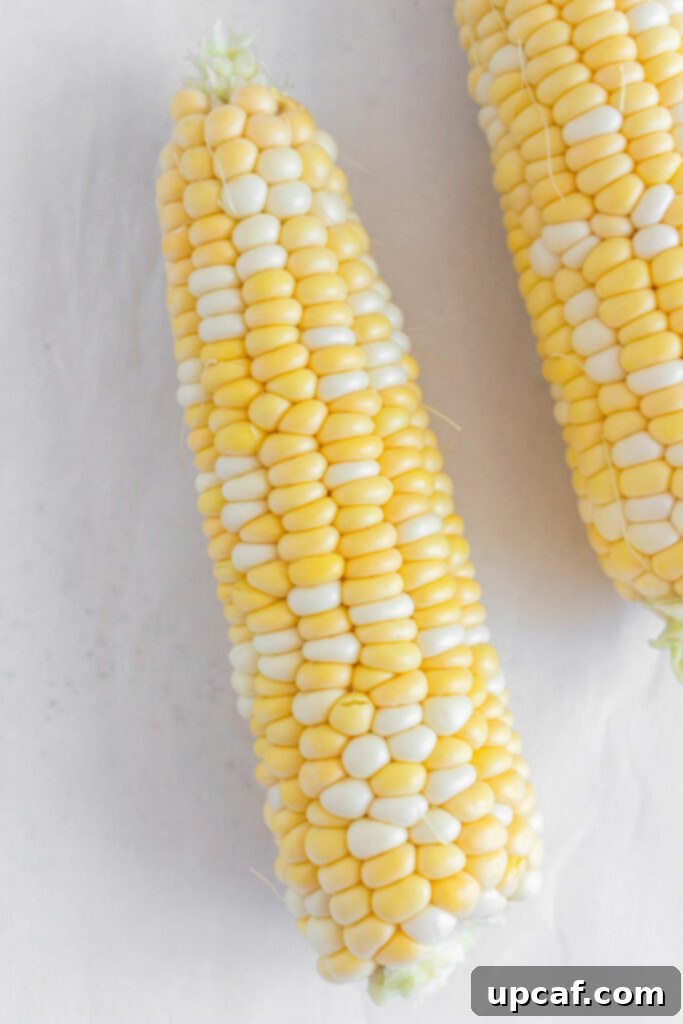
This comprehensive guide will equip you with all the knowledge you need to transform fresh corn into a tender, succulent treat. We’ll dive into 6 distinct and easy methods for cooking corn on the cob, ensuring your kernels are consistently sweet and perfectly tender. From classic boiling to modern Instant Pot techniques, you’ll discover the ideal cooking style to suit your time, equipment, and desired texture. Beyond cooking, we’ll also cover essential tips for selecting the freshest corn at the store, how to effortlessly prepare it, and smart ways to store any leftovers or even freeze it for later enjoyment. Get ready to impress your taste buds and your guests with flawlessly prepared sweet corn!
Why Fresh Corn is a Summer Staple
Corn on the cob isn’t just delicious; it’s also a fantastic addition to a healthy diet. This versatile grain is naturally sweet and incredibly satisfying. Beyond its delightful taste, sweet corn offers a range of nutritional benefits. It’s a good source of fiber, which aids digestion and helps maintain gut health. Corn also contains essential vitamins and minerals, including Vitamin C, B vitamins (like folate), magnesium, and potassium. Plus, it’s packed with antioxidants like lutein and zeaxanthin, which are beneficial for eye health. Incorporating fresh corn into your meals adds a sweet, earthy flavor and a nutritional boost that complements a wide variety of dishes.
Choosing the Perfect Corn at the Store
The secret to great-tasting corn starts with selecting the best ears at the grocery store or farmer’s market. Freshness is key, as corn’s sugars quickly convert to starch after harvesting, leading to a less sweet and sometimes tougher texture. Here’s what to look for when picking your corn:
- Feel for Firmness: Gently squeeze the corn on the cob through the husk. It should feel plump and firm all the way around, with no soft spots or missing kernels. Dents or gaps usually indicate under-developed or damaged kernels.
- Inspect the Husk: The outer husk should be tightly wrapped around the cob, vibrant green in color, and slightly damp to the touch. Avoid husks that are dry, yellowed, or peeling back, as these are signs of older corn.
- Check for Damage: Steer clear of any corn where the husk has small brown holes, which could be an indicator of insect damage.
- Examine the Silk (Tassel): The silk strands sticking out of the top of the husk (often called the tassel) should be light brown or golden, slightly sticky, and smell sweet. If the silk is dry, black, or slimy, the corn is likely past its prime.
- Consider the Weight: A good ear of corn will feel heavier than it looks, indicating juicy, well-developed kernels.
Mastering the Art of Corn Preparation: Shucking and Cleaning
Once you’ve chosen your perfect ears of corn, the next step is preparation. Shucking corn can seem daunting, but it’s quite simple once you know the trick. The easiest and cleanest way to remove the husk and silk is to:
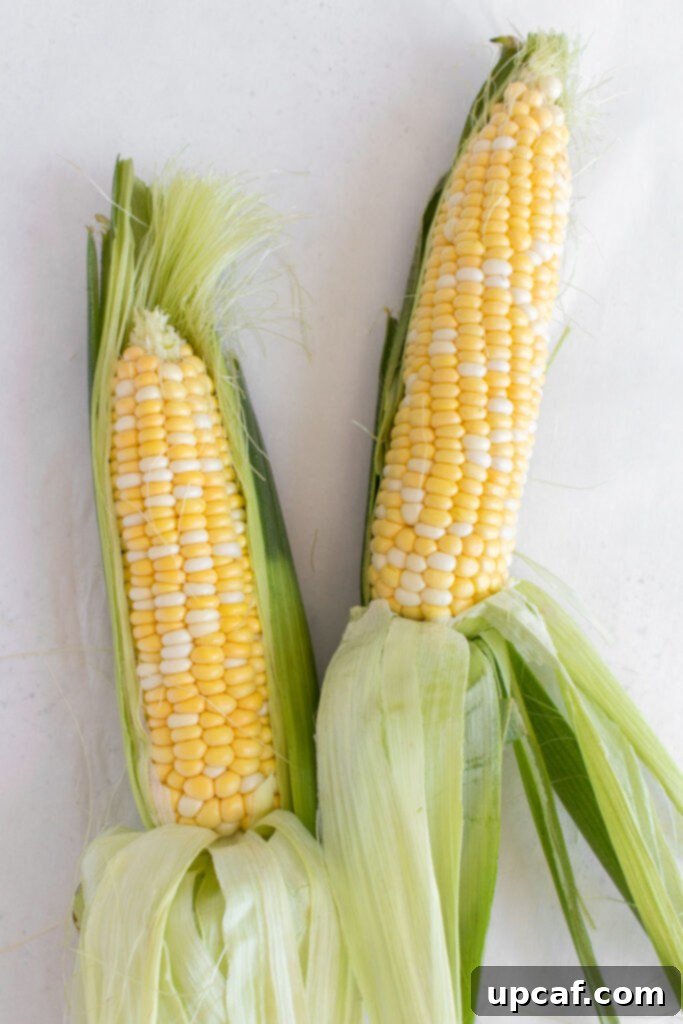
- Peel Down the Husk: Grab the top end of the husk firmly. You can either split the top side of the husk in half or simply pull it all the way down, working towards the base of the cob, much like you would peel a banana.
- Remove the Silk: Once the husk is peeled back, you’ll see the fine, stringy silk strands clinging to the kernels. Gather as much silk as you can in one hand and pull it firmly downwards. For stubborn strands, use a clean kitchen towel, a soft brush, or even a damp paper towel to wipe them away. Some people find that running the cob under cold water while rubbing helps dislodge the silk.
- Break Off the Stem: After removing the husk and silk, you can snap or cut off the stem end of the cob if desired, especially if it’s tough or woody.
All the cooking instructions below are for corn that has been completely shucked and cleaned.
6 Ways to Cook Corn to Perfection
Each cooking method imparts a unique flavor and texture to corn on the cob. Experiment with these different techniques to discover your personal favorite!
1. How to Boil Corn: The Classic & Quick Method
Boiling is perhaps the most traditional and quickest way to cook corn, yielding tender, juicy kernels with minimal effort. It’s perfect when you want that classic sweet corn taste.

- Bring a large pot of unsalted water to a rolling boil. Ensure there’s enough water to fully submerge the corn.
- Carefully add the shucked corn on the cob to the boiling water. Once all corn is added, cover the pot to help the water return to a boil quickly.
- Cook for 5-7 minutes. The exact time depends on the freshness of the corn and your desired tenderness. Fresh, young corn may be ready in as little as 3-4 minutes, while older corn might need closer to 7-8 minutes.
- The corn kernels will become brighter yellow and plump when done. Remove immediately with tongs to prevent overcooking.
- Tip: Avoid adding salt to the boiling water, as it can toughen the corn kernels. You can add a tablespoon of sugar or a pat of butter to the water for extra sweetness and richness.
2. How to Cook Corn in the Instant Pot: Fast & Hands-Off
For a super-fast and incredibly convenient method, the Instant Pot is a game-changer. It locks in moisture and cooks corn evenly without much supervision.

- Add 1 cup of water to the inner pot of your Instant Pot and place the trivet (steamer rack) inside.
- Carefully place the shucked corn on top of the trivet. You can stack them if necessary, but try to ensure even cooking.
- Secure the lid, set the vent to sealing, and cook on High Pressure for 2 minutes.
- Once the cooking cycle is complete, perform a quick release of the pressure. Be cautious of the hot steam.
- Remove the corn promptly and serve.
- Why it works: The pressure cooking environment ensures the corn cooks rapidly while retaining its natural sweetness and moisture.
3. How to Grill Corn: Smoky Flavor Perfection
Grilling corn on the cob infuses it with a delicious smoky flavor and creates beautifully charred kernels, adding an extra dimension to its natural sweetness. It’s a quintessential summer cooking method.
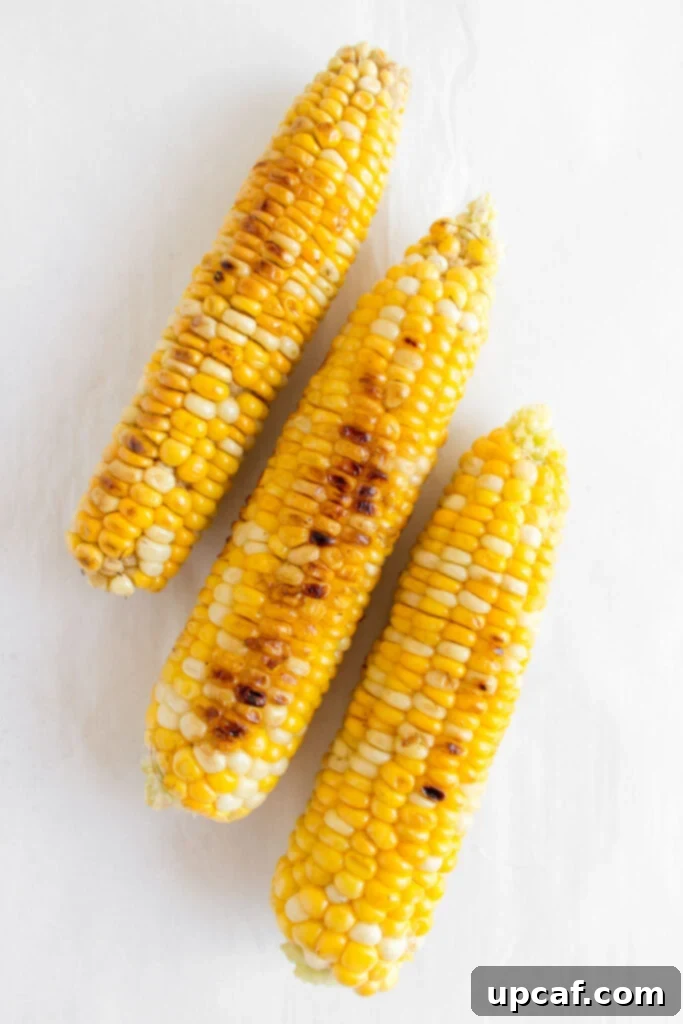
- Preheat your grill to medium-high heat (about 375-400°F or 190-200°C).
- Lightly brush the shucked corn with olive oil, melted butter, or a blend of both. You can also sprinkle with salt, pepper, or your favorite spices at this stage.
- Place the corn directly on the hot grill grates. Cook for 8 to 12 minutes, turning the cobs every 2-3 minutes to ensure even cooking and to develop your desired level of char on all sides. The more you flip, the less intense the char.
- Remove from the grill when the kernels are tender and slightly caramelized.
- Pro Tip: For an even more intense smoky flavor, try grilling corn in its husk directly on the coals for a brief period before shucking and finishing on the grates.
4. How to Microwave Corn: The Fastest Option
When time is of the essence, the microwave is your best friend for cooking a single ear or a small batch of corn quickly and efficiently, producing surprisingly tender results.
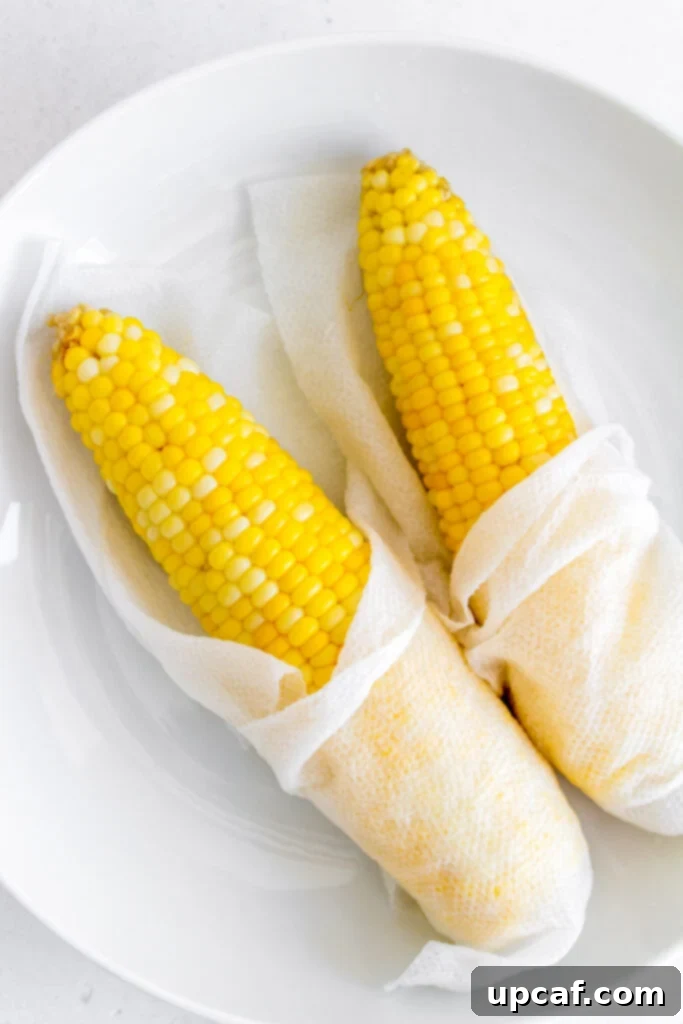
- Take a shucked ear of corn and wrap it tightly in a wet paper towel.
- Place the wrapped corn in a large microwave-safe dish with a lid or cover it with microwave-safe plastic wrap.
- Microwave on high for 3-5 minutes for one ear, or 6-8 minutes for two ears, or until the corn kernels are tender. Cooking times may vary depending on your microwave’s wattage.
- Carefully remove the corn (it will be hot!) and unwrap before serving.
- Benefit: This method keeps the corn incredibly moist, almost like steaming, and requires very little cleanup.
5. How to Oven Roast Corn: Tender & Flavorful with Ease
Oven roasting corn is a fantastic method for hands-off cooking, especially when preparing multiple ears. Wrapping the corn in foil traps moisture and steam, resulting in exceptionally tender kernels.

- Preheat your oven to 375°F (190°C).
- Place each shucked ear of corn on a piece of aluminum foil large enough to wrap it completely. Add a pat of butter, a drizzle of olive oil, and a sprinkle of salt and pepper on top of each cob.
- Tightly wrap each ear of corn in the foil, sealing the edges to create a packet.
- Bake in the preheated oven for 30 minutes, or until the kernels are perfectly tender when pierced with a fork.
- Optional Browning: For a slightly browned or caramelized finish, carefully open the foil packets after baking and broil the corn for 1-2 minutes, watching closely to prevent burning.
- Versatility: You can add herbs like thyme or rosemary, or a slice of lime to the foil packet for infused flavor.
6. How to Steam Corn: Healthy & Retains Sweetness
Steaming is a gentle cooking method that helps retain corn’s natural sweetness, vibrant color, and nutrients. It produces tender, crisp-tender kernels without diluting their flavor.

- In a saucepan or pot, add 1 to 1½ cups of water. Place a steamer insert or basket into the pot, ensuring the bottom of the basket does not touch the water.
- Bring the water to a boil over medium-high heat.
- Once the water is boiling, carefully add the shucked corn to the steamer basket. Place the lid securely on top of the pot.
- Steam for 5-6 minutes, or until the corn kernels are tender and brightly colored.
- Remove the corn immediately and serve hot.
- Health Benefits: Steaming is an excellent choice for a lighter, healthier preparation, as it requires no added fats during cooking.
How to Store Fresh Corn for Optimal Flavor
Proper storage is crucial to preserving the sweet flavor and tender texture of fresh corn. Sweet corn begins to convert its sugars to starch soon after being picked. To slow down this process and keep your corn at its best:
- Store corn on the cob in its husk. The husk acts as a natural protective layer, retaining moisture.
- Place the un-shucked corn in a plastic bag or tightly wrap it in plastic wrap.
- Store it in the crisper drawer of your refrigerator for up to 3 days.
- For the absolute best taste, try to use fresh corn as soon as possible, ideally within 1-2 days of purchase. The longer it sits, the starchier and less sweet it will become.
How to Store Leftover Cooked Corn
If you find yourself with extra cooked corn on the cob, don’t let it go to waste! Cooked corn can be easily stored and reheated for later enjoyment:
- Allow the cooked corn to cool completely to room temperature. This prevents condensation from forming inside the storage container, which can lead to sogginess.
- Wrap individual cobs tightly in plastic wrap or aluminum foil, or place them in an airtight container.
- Store in the refrigerator for up to 5 days.
- To reheat, you can quickly microwave, grill, or briefly boil the corn until warmed through.
Can You Freeze Corn? Extend Your Corn Season!
Absolutely! Freezing is an excellent way to preserve the sweetness and quality of corn, allowing you to enjoy summer’s bounty year-round. There are a couple of ways to freeze corn:
- Freezing Whole Cobs (Blanched): For best results, blanch your corn before freezing. Boil the shucked corn for 2-3 minutes, then immediately plunge it into an ice bath to stop the cooking process. Pat dry, then freeze individual cobs on a baking sheet in a single layer until solid. Once frozen, transfer them to a freezer-friendly airtight plastic bag (like a Ziploc) or a freezer-safe container. This method helps maintain texture and flavor for up to 8-12 months.
- Freezing Kernels: If you prefer to have corn kernels ready for recipes, cut the kernels off the blanched cobs. Spread them in a single layer on a baking sheet and freeze until solid. Then, transfer the frozen kernels to an airtight freezer bag or container. This is great for soups, stews, and casseroles.
- Store frozen corn for up to 8-12 months for optimal quality.
Common Corn Questions Answered
Here are answers to some frequently asked questions about cooking corn:
Can I Add Salt to the Water When Boiling?
It’s generally recommended to skip adding salt to the water when boiling corn. While many vegetables benefit from salted boiling water, salt can actually toughen the kernels of fresh corn, making them less tender and sweet. Save the salt for seasoning the corn after it’s cooked.
How to Tell When Corn on the Cob is Done
Perfectly cooked corn on the cob will be easily recognizable. The kernels will appear a brighter, more vibrant yellow, and they will look plumper. When pierced with a fork or knife, they should be tender and release a milky liquid. The skin should be smooth and taut, not shriveled or dry.
Making Corn for a Crowd? Keep it Warm!
If you’re preparing multiple batches of corn for a large gathering, keeping the cooked ears warm is easy. Once cooked, place the corn into a large baking dish or slow cooker. Cover it tightly with aluminum foil or a lid. You can even place the covered dish in a very low oven (around 150-200°F or 65-90°C) to maintain warmth without continuing to cook the corn.
Elevate Your Corn: Delicious Topping Ideas
While a simple pat of butter and a sprinkle of salt are always delightful, corn on the cob is a fantastic canvas for creative toppings. Here are some fun ideas to take your corn to the next level:
- Mexican Street Corn (Elotes inspired): A flavorful blend of chili powder, crumbled cotija cheese, fresh cilantro, and a squeeze of lime juice.
- Lime-Coconut Crema: A zesty and slightly sweet creamy topping made with lime zest and juice mixed with coconut milk or cream.
- Honey Butter: Softened butter whipped with a touch of honey for a sweet and savory spread.
- Miso Butter: A unique umami-rich butter made by combining softened butter with white miso paste.
- Herb-Infused Butter: Mix finely chopped fresh herbs like chives, parsley, thyme, or rosemary into softened butter.
- Chipotle-Mayo with Lime Juice: A smoky and tangy combination of mayonnaise, adobo sauce from chipotle peppers, and fresh lime juice.
- Spicy Garlic Butter: Melted butter with minced garlic and a pinch of red pepper flakes.
Simple Corn on the Cob Recipe
How to Cook Corn – 6 Ways!
Wondering how to cook corn? Here are 6 different methods to cook corn so that they come out perfectly tender every time!
By: Mariam Ezzeddine
Prep Time: 5 minutes
Cook Time: 30 minutes (average for oven roast, varies by method)
Total Time: 35 minutes
Servings: 4 servings

Ingredients
- 4 whole corn on the cob, husks removed
- Butter, if grilling or oven roasting (optional)
- Olive oil, for grilling (optional)
- Salt and pepper, to taste (for serving)
Instructions
- How to Boil Corn: Bring a large pot of water to a boil. Add the shucked corn and cover the pot to return to a boil. Cook for 5-7 minutes or until the corn kernels are tender. Remove promptly.
- How to Cook Corn in the Instant Pot: Add 1 cup water to the Instant Pot and place the trivet inside. Arrange shucked corn on top of the trivet (stacking if needed). Cook on High Pressure for 2 minutes. Perform a quick release of pressure when done.
- How to Grill Corn: Brush shucked corn with olive oil and/or butter. Place on a hot grill and cook for 8 to 12 minutes, flipping every couple of minutes to achieve desired char on each side.
- How to Microwave Corn: Wrap shucked corn in a wet paper towel. Place in a large microwaveable dish with a lid. Microwave for 3-5 minutes or until kernels are tender.
- How to Oven Roast Corn: Preheat the oven to 375°F (190°C). Place each shucked ear of corn on a piece of tin foil with some butter on top, then tightly wrap. Bake for 30 minutes or until kernels are tender. Optional: broil for 1-2 minutes for browning after unwrapping.
- How to Steam Corn: In a saucepan with a steamer insert, bring 1½ cups of water to a boil (steamer insert should not be submerged). Add shucked corn, place the lid on top, and steam for 5-6 minutes.
Nutrition (Approximate per serving for boiled corn, without toppings)
- Calories: 77 kcal
- Carbohydrates: 17g
- Protein: 3g
- Fat: 1g
- Saturated Fat: 0.3g
- Polyunsaturated Fat: 0.4g
- Monounsaturated Fat: 0.4g
- Trans Fat: 0.01g
- Sodium: 14mg
- Potassium: 243mg
- Fiber: 2g
- Sugar: 6g
- Vitamin A: 168 IU
- Vitamin C: 6mg
- Calcium: 2mg
- Iron: 0.5mg
Whether you’re a seasoned chef or a beginner in the kitchen, mastering how to cook corn on the cob is a rewarding skill that brings joy to any meal. With these 6 versatile methods and comprehensive tips, you’re now ready to prepare perfectly tender and flavorful sweet corn every time. Don’t hesitate to experiment with different toppings and serve this beloved vegetable alongside your favorite dishes.
I hope you find these tutorials helpful and enjoy incorporating fresh corn into your cooking. Try these methods, savor the delicious results, and share your culinary successes with friends and family!
If you try any of these methods and love them, please share your creations with me on INSTAGRAM using my hashtag for a chance to be featured! Also, follow Cookin’ With Mima on FACEBOOK | INSTAGRAM | PINTEREST for all the latest social posts and delicious recipes.
